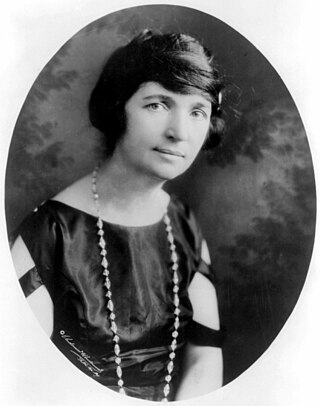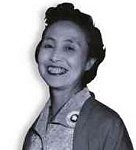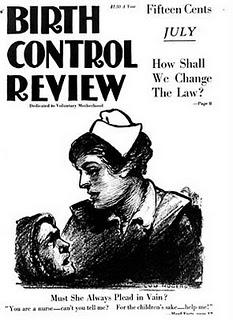Related Research Articles

Margaret Higgins Sanger, also known as Margaret Sanger Slee, was an American birth control activist, sex educator, writer, and nurse. Sanger popularized the term "birth control", opened the first birth control clinic in the United States, and established organizations that evolved into the Planned Parenthood Federation of America.
The American Birth Control League (ABCL) was founded by Margaret Sanger in 1921 at the First American Birth Control Conference in New York City. The organization promoted the founding of birth control clinics and encouraged women to control their own fertility. In 1942, the league became the Planned Parenthood Federation of America.

United States v. One Package of Japanese Pessaries, 86 F.2d 737, was an in rem United States Court of Appeals case in the Second Circuit involving birth control.

Shidzue Katō, also published as Shidzue Ishimoto, was a 20th-century Japanese feminist and one of the first women elected to the Diet of Japan, best known as a pioneer in the birth control movement.
Clarence James Gamble, was an American medical doctor and the heir of the Procter and Gamble soap company fortune. He was an advocate of birth control and eugenics, and founded Pathfinder International.

The National Birth Control League was a United States organization founded in the early 20th century to promote sex education, the use of means and methods to prevent conception, to lobby for a change in legislation making this illegal, and to bring up courtcases with the aim to change jurisprudence, enabling birth control.
The first ever World Population Conference was held at the Salle Centrale, Geneva, Switzerland, from 29 August to 3 September 1927. Organized by the forerunner of the United Nations, the League of Nations, and Margaret Sanger; the conference was an attempt to bring together international experts on population, food supply, fertility, migration and health to discuss the problem of human overpopulation. The conference was organized with funds donated by Sanger's husband, J. Noah Slee, as well as a grant from the Rockefeller Foundation. Sir. Bernard Mallet presided over the meeting, and William H. Welch was vice-president.

Maafa 21: Black Genocide in 21st Century America is an anti-abortion documentary film produced by anti-abortion activist Mark Crutcher in 2009. The film, which has been enthusiastically received by anti-abortion activists, argues that the modern-day prevalence of abortion among African Americans is rooted in an attempted genocide or the maafa of black people. The film is part of an anti-abortion, anti-birth control campaign aimed at African Americans.

Katharine Martha Houghton Hepburn was an American feminist social reformer and a leader of the suffrage movement in the United States. Hepburn served as president of the Connecticut Woman Suffrage Association before joining the National Woman's Party. In 1923 Hepburn formed the Connecticut Branch of the American Birth Control League with two of her friends, Mrs. George Day and Mrs. M. Toscan Bennett. She was the mother and namesake of actress Katharine Hepburn and the grandmother and namesake of actress Katharine Houghton.

The birth control movement in the United States was a social reform campaign beginning in 1914 that aimed to increase the availability of contraception in the U.S. through education and legalization. The movement began in 1914 when a group of political radicals in New York City, led by Emma Goldman, Mary Dennett, and Margaret Sanger, became concerned about the hardships that childbirth and self-induced abortions brought to low-income women. Since contraception was considered to be obscene at the time, the activists targeted the Comstock laws, which prohibited distribution of any "obscene, lewd, and/or lascivious" materials through the mail. Hoping to provoke a favorable legal decision, Sanger deliberately broke the law by distributing The Woman Rebel, a newsletter containing a discussion of contraception. In 1916, Sanger opened the first birth control clinic in the United States, but the clinic was immediately shut down by police, and Sanger was sentenced to 30 days in jail.

The Clinical Research Bureau was the first legal birth control clinic in the United States, and quickly grew into the leading contraceptive research center in the world. The CRB operated under numerous names and parent organizations from 1923 to 1974, providing birth control and infertility clinical services to thousands of patients, and serving as a site for medical research and education on these topics.

Birth Control Review was a lay magazine established and edited by Margaret Sanger in 1917, three years after her friend, Otto Bobsein, coined the term "birth control" to describe voluntary motherhood or the ability of a woman to space children "in keeping with a family's financial and health resources." Sanger published the first issue while imprisoned with Ethel Byrne, her sister, and Fannie Mindell for giving contraceptives and instruction to poor women at the Brownsville Clinic in New York. Sanger remained editor-in-chief until 1928, when she turned it over to the American Birth Control League. The last issue was published in January 1940.
The Birth Control International Information Centre (BCIIC) (1929–38) was a London-based independent, international clearinghouse for birth control information established by American birth control leader Margaret Sanger and British suffragist Edith How-Martyn. It supported the establishment of clinics and maternity advice centers abroad, sponsored lecture tours and a conference.
Dorothy Hamilton Brush was a birth control advocate, women's rights advocate and author. She worked with Margaret Sanger and the birth control movement and wrote plays, travel articles, and books

Betty Mary Goetting was an American librarian, civic leader and women's rights activist. She is known for bringing Planned Parenthood to El Paso, Texas.
The National Committee on Federal Legislation for Birth Control was a birth control lobbying organization set up in 1929 in Chicago by Margaret Sanger and the Illinois Birth Control League.

Juliet Barrett Rublee was an American birth control advocate, suffragist, and film producer. She was married to George Rublee.
Family Limitation is a pamphlet written by American family planning activist, eugenicist, educator, writer, and nurse Margaret Sanger that was published in 1914. It was one of the first guides to birth control published in the United States. The 16-page pamphlet details information on, and ingredients for, various contraceptive methods and included illustrations and instructions for use. After the pamphlet was released, Sanger was forced to flee the United States to Britain to avoid prosecution under federal anti-obscenity laws, the Comstock Act, which prohibited disseminating information about contraception.

Edna Bertha Rankin McKinnon was an American social activist for birth control. She was the executive director of the Chicago Planned Parenthood chapter.
Florence Rose was an American birth control activist, perhaps best known for serving as the secretary of Margaret Sanger for more than a decade.
References
- "Birth Control Council of America", NYU Margaret Sanger Papers Project, "Birth Control Council of America"
- Engelman, Peter, History of the birth control movement in the United States, p 171.